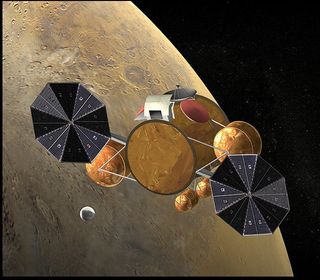
The next steps in NASA's Mars exploration strategy should build toward returning Martian rocks and dirt to Earth to search for signs of past life, a new report by the space agency's Red Planet planning group finds.
The report, released today (Sept. 25) by the Mars Program Planning Group (MPPG), lays out a series of options that NASA could employ to get pieces of the Red Planet in scientists' hands here on Earth. The space agency is now mulling those options and could announce its chosen path by early next year, when the White House releases its proposed budget for fiscal year 2014.
"The first public release of what plans, you know, we definitively have would not be until the president presents that budget to Congress in February of 2013," John Grunsfeld, associate administrator for NASA’s Science Mission Directorate, told reporters today.
NASA put together the MPPG this past March to help restructure its Mars strategy in the wake of cuts to the space agency's robotic exploration program.
The MPPG was instructed to consider NASA's newly constrained fiscal situation and the priorities laid out by the U.S. National Research Council's Planetary Science Decadal Survey, which was released last year. President Barack Obama's directive that the agency get astronauts to the vicinity of Mars by the mid-2030s was another factor, NASA officials said.
The MPPG's focus on sample-return should thus come as no surprise. It was a top priority of the Decadal Survey, and sample-return could help spur and work in concert with NASA's plans for human exploration of Mars, Grunsfeld said. [7 Biggest Mysteries of Mars]
"Sample-return represents the best opportunity to find symmetry technologically between the programs," he said. "Sending a mission to go to Mars and return a sample looks a lot like sending a crew to Mars and returning them safely."
Get the Space.com Newsletter
Breaking space news, the latest updates on rocket launches, skywatching events and more!
Humans could even be involved in the sample-return process, according to the MPPG report. Astronauts aboard NASA's Orion capsule, which is currently under development, could intercept the Martian sample in deep space, secure it in a contained environment, and bring it safely down to Earth.
"It is taking advantage of the human architecture, because we anticipate it will be there," Grunsfeld said. "And it potentially solves an issue of, when we return samples, somewhere we have to make sure that the samples are completely contained so there's no chance — remote as it may be — that there is something on Mars that could contaminate Earth."
Exactly when a Martian sample could come down to Earth remains up in the air. But NASA is considering launching the first enabling mission along this path in 2018, or perhaps 2020, Grunsfeld said. A complicating factor is that NASA has just $800 million or so to work with for the project through 2018.
That's "not enough to encompass the rover options that we talked about," said MPPG team lead Orlando Figueroa. "That drives you to either launching an orbiter first, or delaying to the next opportunity, 2020, to start with a rover."
The report also provides a variety of options for gathering and returning Red Planet samples.
For example, it could all be done with a single launch, which would carry a soil-collecting rover, a vehicle that would blast the samples off the Martian surface and an orbiter for sample rendezvous and return. Or these payloads could be divided among two or three launches, to spread cost and risk around, Figueroa said.
The MPPG report discusses lofting the single-shot mission as early as 2024, aboard NASA's huge Space Launch System rocket. NASA wants the SLS to make its first test flight by 2017 and to be ready to carry crews by 2021.
NASA's robotic Mars exploration strategy has already begun shifting from "follow the water" — exemplified by NASA's Spirit and Opportunity rovers — to searching for habitable environments, which the $2.5 billion Curiosity rover is currently doing in the Red Planet's Gale Crater.
Sample-return is the logical next step in NASA's unmanned activities at Mars, Figueroa said.
"This is really the search for evidence of past life," he said. "And the options that we are putting forth is, What are the options that NASA could have available to pursue it in the most aggressive way possible?"
NASA has two robotic Mars missions on the docket before the first step toward sample-return would launch. The Maven orbiter is slated to blast off next year to study the Red Planet's atmosphere, while a mission called InSight will launch in 2016 to probe Mars' core.
Follow SPACE.com senior writer Mike Wall on Twitter @michaeldwall or SPACE.com @Spacedotcom. We're also on Facebook and Google+.

Join our Space Forums to keep talking space on the latest missions, night sky and more! And if you have a news tip, correction or comment, let us know at: community@space.com.

Michael Wall is a Senior Space Writer with Space.com and joined the team in 2010. He primarily covers exoplanets, spaceflight and military space, but has been known to dabble in the space art beat. His book about the search for alien life, "Out There," was published on Nov. 13, 2018. Before becoming a science writer, Michael worked as a herpetologist and wildlife biologist. He has a Ph.D. in evolutionary biology from the University of Sydney, Australia, a bachelor's degree from the University of Arizona, and a graduate certificate in science writing from the University of California, Santa Cruz. To find out what his latest project is, you can follow Michael on Twitter.
